What pipe to do heating: a review of materials on the market
In this article we will tell you about the instruction for choosing pipes for the construction of heating systems in apartments and country houses. The topic of the article is of considerable interest, since many property owners with capital repairs change old communications to something newer, more efficient, economical and aesthetically perfect.
Considering that the price of modern plumbing accessories is high, it is necessary to take particular responsibility for the choice of pipes and fittings suitable for the construction of heating.
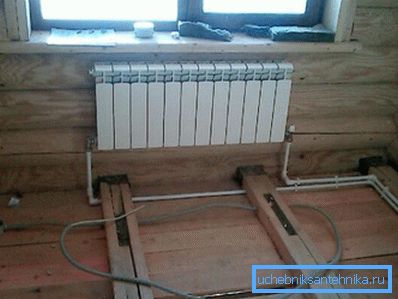
Main varieties
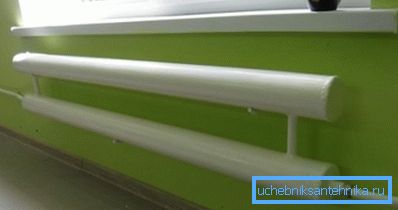
Regardless of what is being built: one-, two- or four-pipe heating system, it is customary to use certain categories of pipes that are resistant to the high temperature of the transported medium, high pressure and sufficient thermal conductivity in order to release heat to the external environment like radiators.
In accordance with the material used in the production, all modern heating systems are divided into metal and polymer modifications.
Metal pipe category is represented by:
- Copper products, which are little used because of the high cost and nevertheless, are characterized by durability and resistance to corrosive processes.
- Steel products, which are traditionally used for the device of central and autonomous heating systems, but when carrying out repair work, change to polymer counterparts.

Polymeric pipes are presented by the following versions:
- Polypropylene products - used primarily for the installation of individual heating systems with a maximum temperature of the transported medium of no more than +90? С with an internal pressure of no more than 10 atmospheres.
- Polypropylene reinforced products - used for central and autonomous systems with a maximum internal pressure of up to 25 atmospheres.
- Metal Products it is distinguished by its mediocre strength, frequent leaks at the interface, and, as a result, a limited operational resource compared to polypropylene.
So, we have considered the main types of pipes, and now we will define what their technical and operational characteristics are.
Rolled steel - the traditional solution
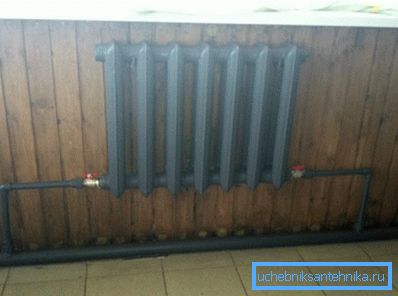
In public buildings, heating registers are used from a profile pipe, while apartments use a central heating system. And in fact, and in another case, used components made of steel.
Modern steel pipes are made using ferrous metal or alloys with the addition of zinc and chromium. The use of products from alloys is preferable, since they are characterized by greater resistance to oxidative processes.
If you plan to use rolled ferrous metal, it is advisable to use products that are galvanized on the outside and the inside. Installation of steel pipes is carried out by means of a threaded connection using special fittings.
A wide range of pipe sizes and configurations of fittings greatly simplifies the design and construction of heating with their own hands.
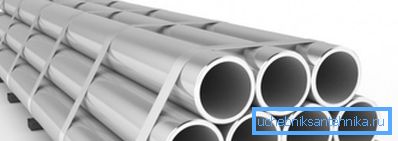
A significant drawback of rolled steel is the inexpediency of use with modern high-tech boilers. As exploitation proceeds, the inner surface of the steel is covered with oxides, even despite the galvanizing layer.
As a result, particles of oxides periodically clog the filters at the entrance to the heating boiler, which prevents the normal operation of the system as a whole. The problem can be solved by using stainless steel, but its price is high.
Copper pipes: features of operation

Copper has long been used for the production of water pipes and heating.
And this is not surprising, since this type of pipe is characterized by such advantages as:
- excellent appearance;
- service life of up to 100 years, provided proper installation;
- maximum corrosion resistance;
- no restrictions on the temperature of the transported medium;
- resistance to high internal pressure;
- optimum fitness for use with various types of heating equipment.
Among the shortcomings can be noted only the high cost, which, however, is compensated by the previously listed advantages.
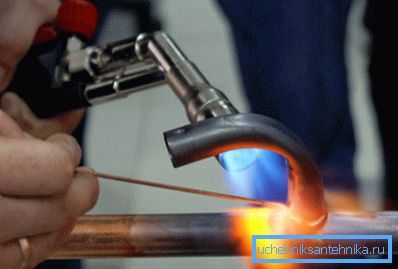
Installation of copper pipelines is carried out by soldering or using press fittings, collet or threaded connections. The listed installation technologies imply the need for a special tool and the relevant experience.
Metalloplast - symbiosis of aluminum and polymeric materials

Despite the fact that the selection of heat from the heating pipe it is advisable to do with the use of copper or steel rolled products, it was metal-plastic that made the manufacture of the pipeline affordable to many. Only with the advent of metal-plastic pipes and related materials, any novice plumber was able to assemble systems of varying degrees of complexity.
The installation of metal-based laminate is performed using press fittings and a collet connection. The use of a press-fitting is preferable, since it is characterized by greater reliability in comparison with the option where the collet and the nut are used.
Important: Many experts consider the use of a collet connection impractical, since most of the inexpensive fittings are of low quality and become unusable after a couple of years of operation.
Metal-plastic is characterized by a good appearance that allows you to build systems that are guaranteed to fit into the interior of most residential premises. In addition, the inner surface of such pipes is characterized by smoothness, which reduces the likelihood of clogging.
Again, the inner polymer shell eliminates the reaction to the transported coolant.
Important: Systems assembled with the use of metal-based laminate can be placed outside or can be hidden in plaster. When laying in plaster, it is advisable to use a connection on the basis of a press fitting.
Polypropylene pipes
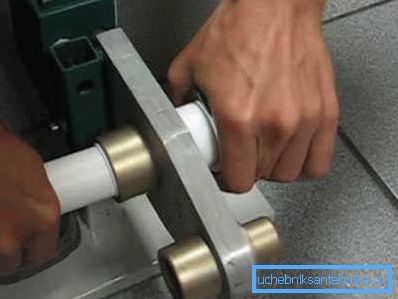
Such pipes instead of radiators are not used, because, unlike metal, the polymer material has a lower thermal conductivity. Perhaps this is the only drawback of products made of polypropylene. And for this reason, such material everywhere crowds out traditional, seemingly time-tested solutions.
Among the advantages of polypropylene are the following:
- the ability to do it yourself using inexpensive tools available in specialized stores;
- low price of the pipes and connecting elements themselves;
- accuracy and aesthetic appeal of a properly assembled system;
- the possibility of external and hidden laying of communications;
- adaptability of the material to the use of antifreeze as a coolant;
- the operational life of a properly assembled system is up to 50 years without the need for regular maintenance and repair.
Reinforced polypropylene - advantages are obvious
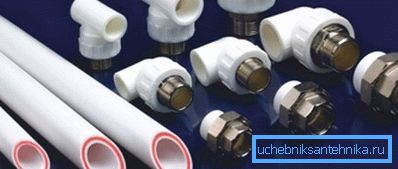
If ordinary polypropylene pipes are characterized by many advantages, analogs made with the use of reinforcing materials are even better!
Currently, there are four types of such products on the market:
- Modifications reinforced with solid aluminum sheet are used in structures with a high level of internal pressure.. During installation, the reinforcing layer is cut a short distance from the end, and then welding is performed.
- Modifications, aluminum reinforcement in the middle of the wall, can be used in both autonomous and central heating systems. A significant advantage of this reinforcement is strength combined with the ability to mount without first stripping the upper layer.
- Modifications reinforced with fiberglass also have a reinforcing layer located between the two polymer layers. The material does not require stripping before installation, in addition, it is no less durable and durable than analogs, reinforced with aluminum foil.
- Modifications reinforced with composite materials can be used for both external and hidden installation.. The cut of the product does not have a layered pattern, since the glass fiber is mixed with a layer of polypropylene, which provides greater strength and resistance to mechanical loads.
Conclusion
So, we found out that smooth and finned heating pipes can be made of different materials and this determines their technical and operational characteristics. It remains to decide what to choose.
Based on the above, the following conclusion can be drawn:
- If you plan to build a budget and durable heating system - the best choice is polypropylene on welded joints.
- If an exclusive, but less efficient and durable system is built, the best choice would be copper on soldered joints or stainless steel on threaded fittings.
More useful and interesting you can find by watching the video in this article.